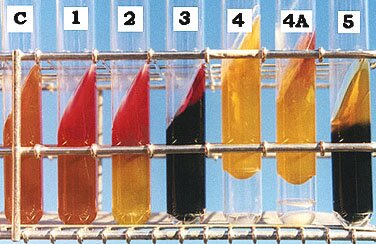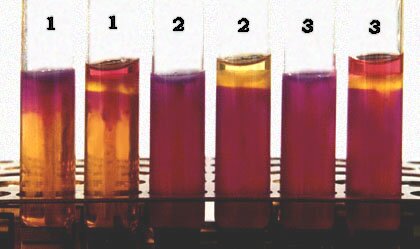Overview of Differential Features of KIA and MIO
| |
Kligler Iron Agar (KIA) |
Motility Indole Ornithine
(MIO) Medium |
| source of amino acids which may be deaminated (alkaline rx.) |
peptone,
proteose peptone,
beef extract,
yeast extract |
peptone,
yeast extract,
ornithine |
| amino acid added to note its decarboxylation (alkaline rx.) |
none |
ornithine |
| fermentable sugar(s) (acid rx.) |
lactose (1%) and
glucose (0.1%) |
glucose (0.1%) |
| pH indicator |
phenol red:
net acid = yellow,
net alkaline = red |
brom-cresol purple:
net acid = yellow,
net alkaline = purple |
| source from which H2S may be produced |
sodium thiosulfate |
none |
| indicator of H2S production |
ferrous sulfate |
none |
Kligler Iron Agar (KIA)
Note the relative amounts of sugars in KIA according to the table seen above. By the degree of acid produced from fermentation, differentiation can be made between non-fermenters, glucose-fermenters (which produce a relatively small amount of acid) and those which ferment both glucose and lactose (producing a relatively large amount of acid which diffuses througout the medium and easily overneutralizes the aerobic deamination reaction in the slant). Organisms which produce hydrogen sulfide from the reduction of thiosulfate are easily detected; the H2S reacts with the iron in the medium to produce ferrous sulfide, a black precipitate. The medium is inoculated with the needle, first stabbing down the center to the bottom of the tube and then streaking up the slant. Incubation is for one day at 37°C. The various combinations of reactions are explained and illustrated below. (Tube "C" is the uninoculated control tube which shows an orange (neutral) reaction throughout.)
 |
| corresponding tube no. above |
1 |
2 |
3 |
4* |
5** |
| deamination of amino acids (aerobic alkaline rx.) |
+ |
+ |
+ |
+ |
+ |
| glucose fermentation (minor acid rx.) |
– |
+ |
+ |
+ |
+ |
| lactose fermentation (major acid rx.) |
– |
– |
– |
+ |
+ |
| H2S production (black color) |
– |
– |
+ |
– |
+** |
| typical examples |
Pseudomonas
(a non-enteric) |
Morganella,
Providencia,
Shigella |
Citrobacter,
Salmonella,
Proteus,
Edwardsiella |
E. coli,
Enterobacter,
Klebsiella |
coliform strains of
Citrobacter that are H2S+,
H2S+ E. coli,
lactose+ Salmonella |
* Tube 4: Much gas is often seen for this tube, evidenced by cracks in the medium. Also, lactose fermenters which are methyl red-negative may show a "reversion" toward an alkaline reaction as neutral products are formed from some of the acid. This appears as shown in Tube 4A where a slight reddening of the slant occurs as the alkaline deamination reaction becomes no longer over-neutralized by acid from fermentation. How might such a tube appear after two or more days of incubation? (Recall the methyl red test.)
** Tube 5: Enough acid can be produced to cause the black iron sulfide precipitate to break down and not be seen. In this case, the tube will look like no. 4. |
Motility Indole Ornithine (MIO) Medium
The reactions in this medium are observed as follows:
- Motility. Observe for cloudiness in the medium (growth away from the stab line). For a non-motile organism, growth may be seen along cracks in the medium caused by gas production, but there will be clear pockets of no growth.
-
Ornithine Decarboxylation. Observe the lower three-quarters (anaerobic region) of the medium for change in color of the pH indicator; growth must be present in this part of the tube for correct analysis of result:
- Gray, blue or purple color: Positive reaction for ornithine decarboxylation – formation of a highly alkaline product, over-neutralizing the acid produced from glucose fermentation.
- Yellow color: Negative reaction. Yellow color is due to the "default" acid production from glucose fermentation.
- Indole Production. About one-half dropperful of Kovacs reagent is added to the medium. A red ring indicates production of indole from the breakdown of tryptophan.
 |
| corresponding tube no. above (tubes arranged in pairs with Kovacs reagent added to right tube in each pair) |
1 |
2 |
3 |
| deamination of amino acids (aerobic alkaline rx.) |
+ |
+ |
+ |
| motility (cloudiness – disregarding stab line) |
– |
+ |
+ |
| decarboxylation of ornithine (anaerobic alkaline rx.) |
– |
+ |
+ |
| indole production (red color with Kovacs reagent) |
+ |
– |
+ |
| glucose fermentation (acid rx.) |
+ |
+ |
+ |
typical examples
|
Klebsiella
oxytoca |
Enterobacter
aerogenes |
Escherichia
coli |
|

